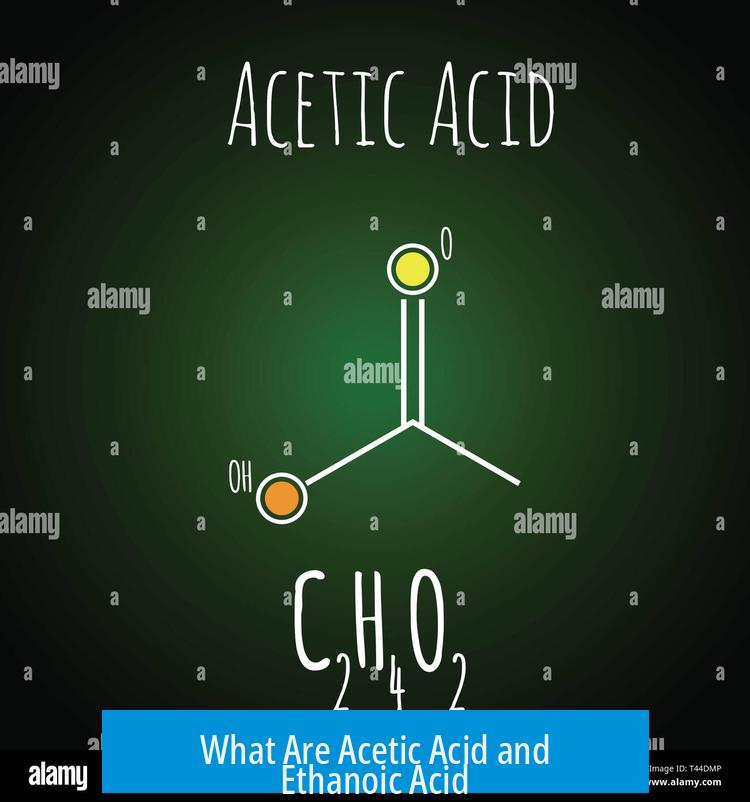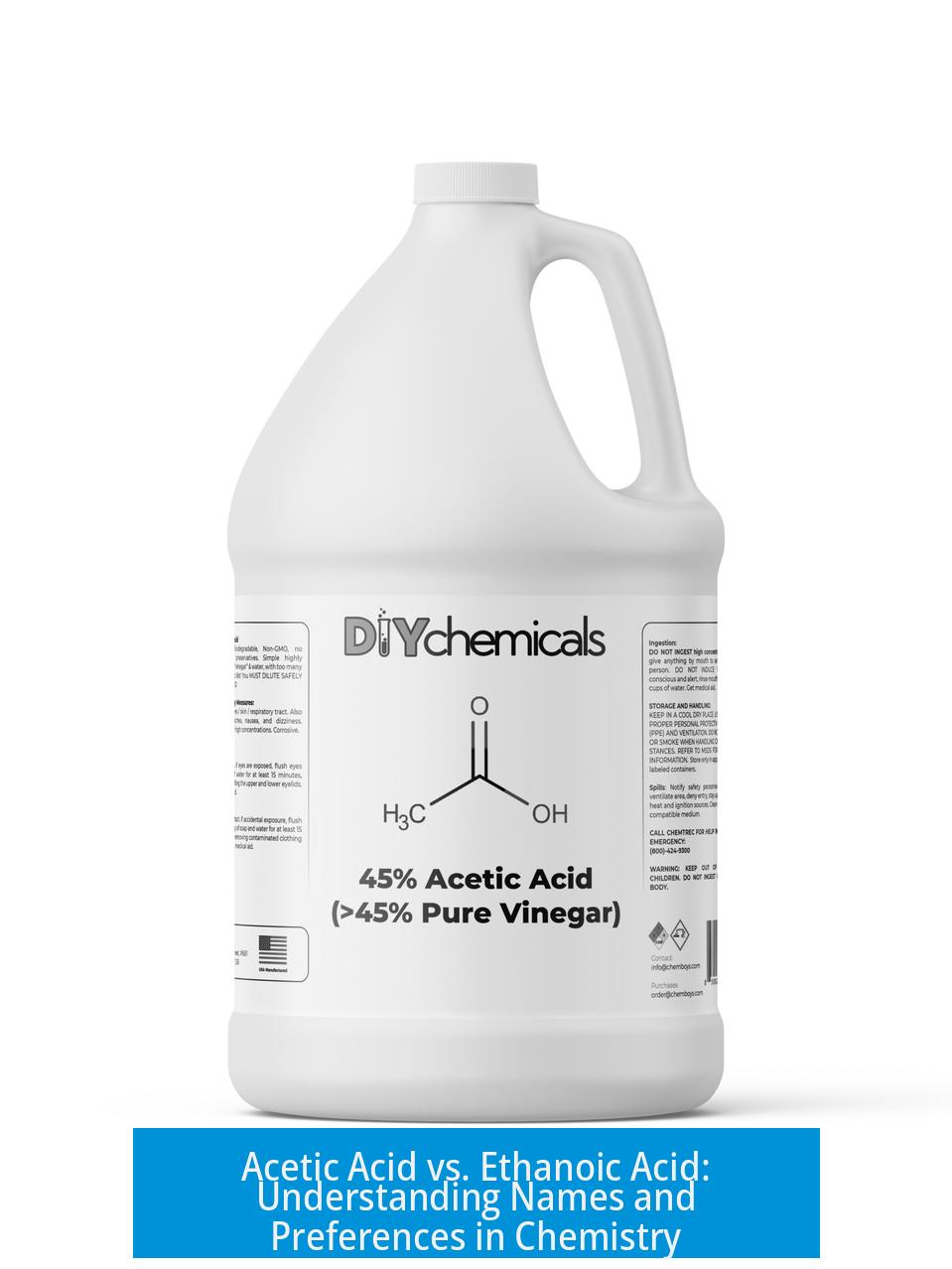Acetic Acid or Ethanoic Acid? Understanding the Naming Conventions and Usage
Acetic acid and ethanoic acid refer to the same chemical compound, CH3COOH, but the preferred term is overwhelmingly “acetic acid” in practical, industrial, and research settings worldwide, while “ethanoic acid” is primarily used in educational contexts following IUPAC nomenclature rules. Understanding the distinction lies in recognizing the environment, geographical influences, and the balance between trivial and systematic naming conventions.
What Are Acetic Acid and Ethanoic Acid?

Both terms describe the carboxylic acid with the molecular formula CH3COOH. This compound is a key organic acid notable for its sour taste and pungent smell. It occurs naturally in vinegar and serves extensive uses in chemical manufacturing, food preservation, and industrial applications.
The term “acetic acid” is the traditional common or trivial name, while “ethanoic acid” is its formal IUPAC name. The “ethanoic acid” name reflects its structure in organic nomenclature—a two-carbon carboxylic acid derived from ethane.
Why “Acetic Acid” Dominates Usage
Practical Chemistry and Professional Preference
- In laboratories, industry, and research, “acetic acid” is the universally recognized and used term.
- Experienced chemists rarely call it “ethanoic acid” in day-to-day practice. Instead, they prefer the familiar traditional name because it is simple and well established.
- Examples include the use of “glacial acetic acid,” never “glacial ethanoic acid,” in product labeling and protocols.
- The term “acetic acid” is entrenched globally, from the US and UK to mainland Europe, Asia, and beyond.
- Trivial names like “acetic acid,” “toluene,” and “acetone” persist because they are concise, easier to say, and widely understood.
Cultural and Geographic Trends
| Region | Common Usage | Notes |
|---|---|---|
| United Kingdom | Both names appear in education; “acetic acid” dominates university and professional settings | Schools and GCSE syllabi emphasize “ethanoic acid” for teaching nomenclature; the switch to “acetic acid” occurs in higher education. |
| United States | Almost exclusively “acetic acid” in academic and professional contexts | Less emphasis on systematic names in undergraduate courses, favoring historical trivial names. |
| Netherlands and Continental Europe | Predominantly “acetic acid” among chemical engineering and biomedical students | Some exposure to systematic nomenclature in education, but the trivial name is predominant. |
| Germany | Recognition of both names but practical preference for “acetic acid” | Indicates the wider European trend of retaining trivial names in practice. |
Ethanoic Acid: The Educational and Nomenclature Perspective
Ethanoic acid emerges mainly in academic contexts for the following reasons:
- IUPAC nomenclature introduces students to systematic naming conventions early on.
- Instruction of “ethanoic acid” helps students understand how carboxylic acids are named based on their carbon chain.
- Using “ethanoic acid” allows easier transition to naming complex molecules and less familiar acids based on substituent and chain length rules.
- Typically, elementary and secondary education emphasize “ethanoic acid” for exams and standardized curricula, especially in the UK and some other countries.
However, after foundational chemistry education, students often adopt “acetic acid” in practical and professional communication.
Balancing Educational Needs with Practical Communication
For students:
- Using “ethanoic acid” helps grasp systematic nomenclature rules essential for advanced studies.
- It prepares students for clearly understanding naming structures in organic chemistry.
For professionals:
- The focus shifts to ease of communication and shared understanding.
- “Acetic acid” is preferred because it carries historical and practical recognition.
- Enforcing systematic names like “ethanoic acid” in professional settings often causes confusion or appears overly pedantic.
Why Do Chemists Prefer Trivial Names Like “Acetic Acid”?
Several factors lead chemists to favor trivial names:
- Historical consistency: “Acetic acid” has been used for centuries and is embedded in most chemical literature, industrial standards, and safety datasheets.
- Simplicity and clarity: Short, well-known names reduce misunderstanding and improve communication efficiency.
- Common use across disciplines: Non-specialists, such as engineers and medical professionals, also recognize trivial names, bridging interdisciplinary communication.
- Limits confusion: Systematic naming may apply to many variations, but trivial names point to a unique, well-characterized compound.
- Resistance to unnecessary change: Concepts like calling water “oxidane” or benzene as “1,3,5-cyclohexatriene” are avoided despite being valid IUPAC names to maintain practical clarity.
Examples of Other Compounds with Similar Naming Practices
- Benzene: Always called benzene rather than the systematic but cumbersome “1,3,5-cyclohexatriene.”
- Acetone: The trivial name for propanone is universally used.
- Formaldehyde: Preferred over “methanal” in many industrial and scientific contexts.
When Might “Ethanoic Acid” Be Appropriate?
While uncommon in practice, there are scenarios where “ethanoic acid” is suitable:
- Teaching formal nomenclature as part of organic chemistry syllabus.
- Discussing naming conventions and chemical education.
- Comparing or classifying related compounds systematically (e.g., propanoic acid, butanoic acid).
- Technical documentation requiring IUPAC name for legal, regulatory, or international purposes.
Nevertheless, familiarity with “acetic acid” remains important in all chemical communication.
Summary of Key Points
- Acetic acid is the predominant name used in research, industry, and professional chemistry worldwide.
- Ethanoic acid is mainly used in educational contexts to teach systematic IUPAC nomenclature.
- Geographically, the UK and some educational systems emphasize “ethanoic acid” early, but usage shifts to “acetic acid” in higher learning.
- In the US, Netherlands, Germany, and many other countries, “acetic acid” is common in academic and professional settings.
- Trivial names persist because they simplify communication and retain historical significance.
- Chemists use systematic names when needed but favor trivial names for clarity and practicality.
- Understanding both names aids clarity, especially during learning and cross-disciplinary communication.
What is the difference between acetic acid and ethanoic acid?
They are the same chemical compound. Acetic acid is the common or trivial name, while ethanoic acid is the correct IUPAC name used in formal chemistry naming conventions. Both refer to CH3COOH.
Why do most chemists prefer the name acetic acid over ethanoic acid?
Acetic acid is widely recognized and used in professional labs and industry. The trivial name is simpler and more familiar. Ethanoic acid is mostly used in educational settings to teach nomenclature rules.
When should ethanoic acid be used instead of acetic acid?
Ethanoic acid is useful in teaching and exams to understand IUPAC rules. It helps students learn systematic naming before switching to common names in practical chemistry.
Does the preference for acetic acid or ethanoic acid vary by country?
Yes, some countries like the UK may teach ethanoic acid in schools, but most chemists revert to acetic acid in university or research. In the US and Netherlands, acetic acid is generally preferred.
Are trivial names preferred over IUPAC names for other chemicals too?
Yes. Many common chemicals like benzene, acetone, and formaldehyde are mostly called by their trivial names rather than strict IUPAC names in practical settings.
Is it correct to call pure acetic acid “glacial ethanoic acid”?
Practically no. The term “glacial acetic acid” is standard. “Glacial ethanoic acid” is rarely used and sounds unusual among practicing chemists.





Leave a Comment